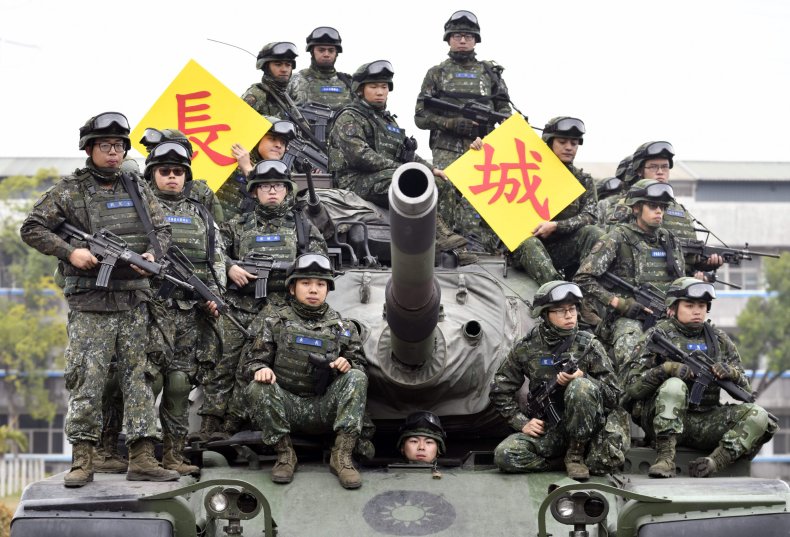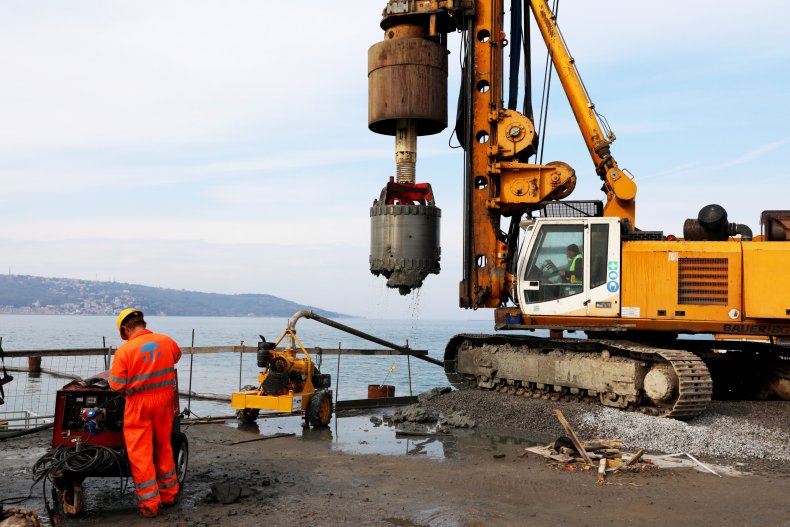BY DAVID BRENNAN
President Barack Obama announced America's "pivot to Asia" in 2011, acknowledging that the future prosperity and influence of the world's wealthiest and most powerful nation would hinge on its presence in the world's most populous continent.
The U.S. pivot to Asia is part of Washington, D.C.'s response to the predicted "Chinese Century," as Beijing comes of age and emerges as the first superpower to challenge U.S. hegemony since the collapse of the Soviet Union. Indeed, some observers have already declared a new Cold War.
Through President Donald Trump's tenure, America's eastwards shift in strategic focus has become more obvious. There are now few in Washington and in capitals across the Western world that do not consider China the greatest strategic challenge facing liberal democracies and the so-called "rules based international order"—sculpted by the U.S. and its allies in the aftermath of World War Two and cemented by the collapse of the USSR.
Trump's tough-on-Beijing rhetoric was a feature of his campaign before he entered the White House. His expansive trade war with China has colored bilateral ties since it began, even though Trump has lauded his personal friendship with President Xi Jinping and praised the dictator's iron grip on power.
Long-term trends have come to the fore during Trump's presidency. China has become more assertive in its neighborhood and unapologetically continued human rights abuses at home. Beijing has expanded its global investment program pushing into Africa, Europe and even South America, while Xi is also keeping a close eye on the Arctic.
China has maintained huge investment in its armed forces—though still dwarfed by the gargantuan U.S. military budget—to create a modern force capable of regional defense and force projection underpinned by potent cyber warfare capabilities.
The most obvious U.S.-China flashpoints are in East Asia. One of China's central goals is to dominate the region and displace post-war U.S. hegemony there. This includes being free to control the South China Sea (regardless of the conflicting territorial claims of its neighbors), take control of democratic Taiwan, and suppress any internal pro-democracy movements in Hong Kong.
On all three issues, the U.S. is pushing back against Beijing, be it with limited success. In Hong Kong, Beijing's new national security law is set to criminalize anti-government dissent and foreign interference, with U.S. legislation and protests so far doing nothing to stay China's hand.
In the South China Sea, the U.S. continues military operations to keep pressure on Chinese forces occupying small reefs and man-made island bases which effectively enforce Beijing's territorial claims, which overlap with several of its neighbors. But for all the American patrols and rhetoric, Beijing has effectively won the South China Sea battle without a shot being fired.
The East China Sea also poses problems as Chinese territorial claims there overlap with those of close U.S. allies Japan and South Korea. Tokyo, Seoul and Washington all will have learned lessons from the South China Sea and will be keen to avoid a repeat. A Chinese-Japanese build-up of radar and missile systems is raising the stakes and danger of accidental conflict here.
Taiwan is probably the biggest prize for an expansionist China. Beijing considers the democratic island part of the "One China," and has vowed to take control of the nation whether by diplomatic or military means.
The U.S. has long supported Taiwan with weapons sales—though it does not officially recognize it as a country—and is bound by law to defend the island from Chinese attack. Such an assault still seems implausible, but Beijing maintains its aggressive rhetoric and military posturing across the Taiwan Strait to the concern of Taipei.
 This file photo shows Taiwanese army soldiers posing for photos on an U.S.-made M60-A3 tank after a life-fire exercise in Taichung, central Taiwan, on January 17, 2019.SAM YEH/AFP VIA GETTY IMAGES/GETTY
This file photo shows Taiwanese army soldiers posing for photos on an U.S.-made M60-A3 tank after a life-fire exercise in Taichung, central Taiwan, on January 17, 2019.SAM YEH/AFP VIA GETTY IMAGES/GETTY
Janka Oertel, the director of the Asia program at the European Council on Foreign Relations think tank, told Newsweek that aggressive Chinese growth "is becoming more likely and it's speeding up," pointing to Hong Kong and the South China Sea as examples.
Hong Kong's unique character was supposed to be protected until 2047 under the terms of its handover from British to Chinese control in 1997, but Beijing now seems keen to discard the deal.
While an invasion of Taiwan seems a long way off, Oertel warned that the COVID-19 coronavirus pandemic has taught the world "that there are plausible contingencies out there for which we are not prepared, this includes especially a potential Taiwan contingency."
The Chinese-Indian border is another flash point that could tangentially affect the U.S. Fighting erupted there over recent weeks along the disputed Himalayan border between the two giants, resulting in several deaths and a sudden diplomatic crisis.
India has a long history of non-alignment and will likely seek to meet the China challenge on its own terms rather than be dragged into a wider U.S.-China face-off. But India is a major weapons purchaser and has been increasing its consumption of U.S. products.
Trump and Prime Minister Narendra Modi have forged what at least seems to be a close working relationship, and the U.S. will undoubtedly hope that New Delhi frustrates Beijing's wider strategy.
Elsewhere the China-U.S. conflict is more likely to be waged through economics, diplomacy and technology rather than conventional warfare of the kinds of asymmetric and civil conflicts that ran through the Cold War.
Trump's time in office has been dominated by his mammoth trade war with Beijing. His administration has habitually used sanctions to undermine adversaries, and the passage of legislation regarding human rights abuses in Hong Kong and Xinjiang opens Chinese officials to such measures.
Meanwhile, the ongoing battle over 5G is the clearest example of technological competition. The U.S. has sought to block the Huawei telecommunications corporation from its domestic market and pressured its allies to do the same, with some success. Washington considers Chinese companies to be arms of the Chinese Communist Party, and is not shy about undermining them.
China had rapidly expanded investment and presence to open up new markets and win greater influence. Beijing's multi-billion Belt and Road initiative will see Chinese-augmented trade routes stretch from China all the way to Western Europe and Africa, prompting concerns that the CCP will meddle in local markets and governments to protect its interests.
This includes so-called debt trap diplomacy, in which China lends large sums of money to poorer countries to embark on infrastructure projects. When these countries default, China takes control of the projects in lieu of payment. This practice—denied by Chinese officials—has already won Beijing control of a Sri Lankan port.
China has been investing huge sums in its military, but to date most of its international outreach has been via investment and trade. But this will eventually bring with it military presence—where there are financial interests and Chinese citizens, there will often need to be force to protect them.
Already Chinese bases have popped up in Djibouti, Myanmar and Tajikistan, while China's debt diplomacy could yet secure more ports elsewhere. "The Chinese navy is already operating around the globe," Oertel said.
In Djibouti, the Chinese base is a few miles from the American Camp Lemonnier, risking friction between the two forces—U.S. pilots have previously reported being harassed with Chinese lasers while landing at the base.
Still, despite Xi's goal to make China a global power, its armed forces are still limited in how far and how effectively they can deploy. The U.S. remains the only world power truly capable of sustained major global operations.
Andrew Small of the ECFR said competition in places like Africa "are less likely to escalate into flashpoints of a military nature given the constraints in China's capacity to operate outside its immediate neighborhood."
Europe too will be a key battleground for competing U.S. and Chinese influence. The continent is traditionally aligned with North America and its most powerful members remain committed to NATO, even if the current president is not a fan of the transatlantic alliance.
But Beijing is making headway, leveraging its technology and wealth to gain influence. European and American officials are warily watching the Balkans where China is gaining a foothold among poorer European nations keen to use Chinese funding to grow and improve their infrastructure.
Europe "is the big prize in the game," Oertel said, noting the dispute over Chinese technology firm Huawei as an early example of what is to come. Europe is "likely only at the start of what could become a very uncomfortable situation for many of the European states," she explained.
"It should prompt us in Europe to work much closer with partners in Asia that are much more experienced in this difficult balancing act."
 This file photo shows the construction of the new logistics platform at the port of Trieste in Italy on April 3, 2019. The project will allow the port to accept Chinese business and investment as part of Beijing's Belt and Road project.MARCO DI LAURO/GETTY IMAGES/GETTY
This file photo shows the construction of the new logistics platform at the port of Trieste in Italy on April 3, 2019. The project will allow the port to accept Chinese business and investment as part of Beijing's Belt and Road project.MARCO DI LAURO/GETTY IMAGES/GETTY
Economic and technological competition will be underpinned by more nefarious means, particularly cyber warfare. Much of this is clandestine and classified, and often details about cyber operations only emerge long after the fact.
This also makes it hard to envisage exactly what such a conflict might look like. "We have not figured out what a major cyber-attack would look like—especially under the condition of increased China-Russia cooperation," Oertel said.
Adversaries could target the U.S military in the field, interfering with satellites and communications to render American forces deaf and blind. On the home front, enemies could target power grids to wreak havoc or undermine major corporations and markets to damage the economy.
The U.S. is already dealing with Chinese cyber attacks targeting lawmakers, elections, academic institutions, and sensitive military and industrial targets, among others. More often than not the goal is to steal intellectual property or classified information, but hackers—both Chinese military and civilian groups—could pivot to more destructive operations.
Justin Sherman, a fellow at the Atlantic Council think tank and an expert in cybersecurity, said the world is yet to see the U.S. and China unleash the full force of their cyber arsenals against each other, "at least publicly."
Still, he said there is a growing awareness in Washington of how and where the Chinese government might seek to leverage its capabilities against U.S. interests. This "below threshold" conflict between the two powers will bubble along without as much coverage as open warfare, Sherman told Newsweek.
Bipartisan recognition of the China challenge precedes a coherent response, which will be more difficult to achieve. Trump has certainly taken the fight to China on a number of issues, but not everyone will agree with his methods.
The president's trade war has cost Americans money and jobs, and his administration's aggressive—and occasionally racist—rhetoric has been slow in turning allies against Beijing. Divisive White House messaging has too often allowed China to play the part of the adult in the room, even while continuing its malign activities.
The challenge will become more pressing as Xi and Beijing grow in confidence, wealth and influence. China's power and global reach should not be overstated—Beijing still does not carry the same clout as Washington—but both are growing while the U.S. grapples with the coronavirus pandemic, its own internal polarization and an increasingly uncertain place within the world order its leaders crafted.
No comments:
Post a Comment